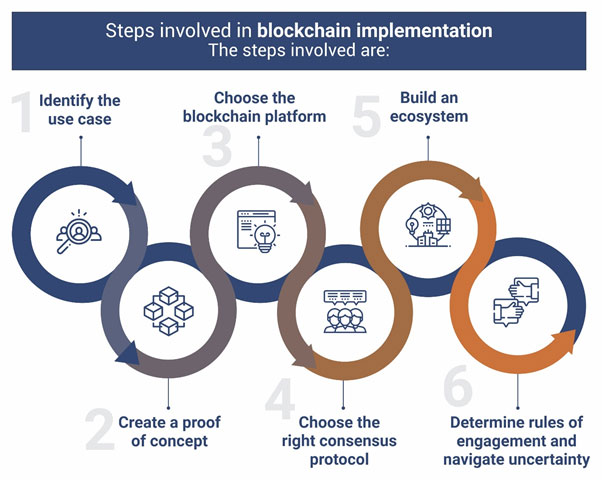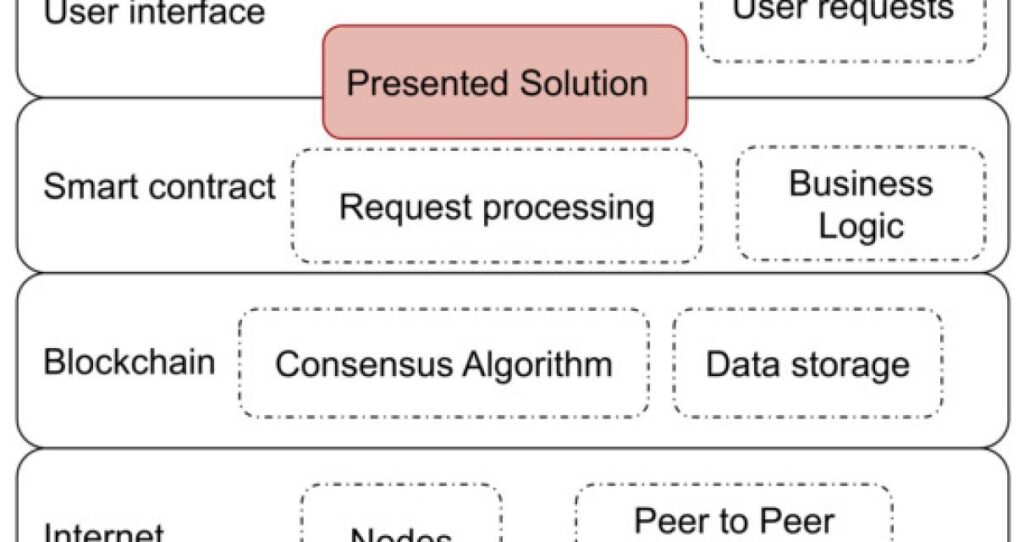Blockchain has been one of the most talked-about technologies over the past few years. It has the potential to revolutionize the way we conduct transactions, store data, and interact with each other online. However, despite its many benefits, implementing blockchain can be a complex and daunting task for businesses and organizations.
If you are looking to implement blockchain in your organization, this guide will provide you with the essential information you need to get started. Whether you are a small business owner or a large corporation, we will explore the key considerations you need to keep in mind when implementing blockchain, including the different types of blockchain, the benefits and challenges of using blockchain, and the steps you need to take to ensure a successful implementation. So, let’s dive in and discover how you can harness the power of blockchain to transform your business.
Implementing blockchain technology is not a difficult task if you have the right resources. Here are the basic steps to get started:
- Understand the basics of blockchain technology, its use cases, and its benefits.
- Choose a platform and technology stack for implementation.
- Design and develop the blockchain application.
- Deploy the application and test it.
- Integrate the application with other systems.
- Monitor the performance of the application.

How to Implement Blockchain
Blockchain is a technology that is revolutionizing the way data is shared, stored, and secured. It is being used in a variety of industries, from finance to healthcare, and is quickly becoming the standard for data management. This article will provide an overview of what blockchain is, how it can be used, and how to implement it in your organization.
What is Blockchain?
Blockchain is a distributed ledger technology that records and stores data in a secure and immutable way. It is a form of public, distributed ledger technology that uses a consensus mechanism to ensure data integrity. It is a decentralized system, meaning that it does not require a central authority to manage and store data. Instead, the data is stored on multiple computers across the world, making it nearly impossible to hack or alter. Blockchain can be used to securely store and transfer data, including financial transactions, contracts, and other sensitive information.
Blockchain technology is based on cryptography, which allows for secure data transmission and storage. This technology also enables smart contracts, which are self-executing agreements that are automatically implemented when the conditions of the contract are met. Smart contracts are becoming increasingly popular in the finance, legal, and healthcare industries.
How Blockchain Works
Blockchain works by using a distributed ledger, which is a shared database of data. All data stored in the ledger is cryptographically signed and secure. The ledger is also constantly updated and maintained on a network of computers, allowing for faster and more secure data transfers. Every transaction that is made is added to the ledger, creating an immutable record of all transactions.
Blockchain also uses a consensus mechanism to ensure that all data is accurate and up-to-date. This mechanism requires all participants in the network to agree on the validity of a transaction before it is added to the ledger. This ensures that all data stored on the ledger is accurate and up-to-date. In addition, this consensus mechanism makes it nearly impossible for malicious actors to manipulate or alter the data stored on the ledger.
Benefits of Blockchain
Blockchain technology offers many benefits to organizations, including increased security, faster transaction times, and cost savings. Firstly, blockchain is more secure than traditional databases because it is immutable and distributed. This makes it nearly impossible to hack or alter data stored on the ledger. Secondly, blockchain technology allows for faster transaction times because it eliminates the need for intermediaries such as banks or brokers. Finally, blockchain can reduce costs associated with data storage and transaction processing.
Blockchain technology also allows for greater transparency and traceability. Every transaction on the ledger is cryptographically signed and can be traced back to its original source. This allows organizations to easily track and verify data, ensuring that all transactions are accurate and authentic.
How to Implement Blockchain
Implementing blockchain technology in an organization requires a comprehensive plan that incorporates both technical and organizational changes. The first step is to assess the organization’s current data management system and identify areas where blockchain technology can be used to improve efficiency or security. The next step is to select a blockchain platform that meets the organization’s specific needs. After the platform is selected, the organization must develop smart contracts and applications that can be used to store and transfer data securely.
Once the platform is established, the organization must determine how to integrate it into their existing data management system. This can involve rewriting existing applications to use blockchain technology or integrating blockchain technology into existing systems. Finally, the organization must develop a comprehensive security plan to ensure that the data stored on the blockchain is secure and that all transactions are verified and authenticated.
Frequently Asked Questions
Blockchain is a distributed ledger technology that enables the secure storage and transmission of digital data. It is becoming increasingly popular due to its ability to provide secure, transparent, and immutable data storage and transaction processing.
What is Blockchain?
Blockchain is a digital ledger technology that allows for the secure storage and transmission of data. It is composed of a chain of blocks, each of which contains a cryptographic hash of the previous block, a timestamp, and transaction data. This creates an immutable and secure system that can be used for a variety of applications. Blockchain technology has the potential to revolutionize the way we store and transfer data, as well as how we use digital currencies.
Blockchain technology is also being used in a variety of other applications, such as smart contracts, digital identity management, and supply chain management. Furthermore, its use is expanding into areas such as healthcare, energy, and voting.
How can Blockchain be Implemented?
There are several ways to implement a blockchain system. The most common approach is to use a distributed ledger technology (DLT) such as Hyperledger Fabric or Ethereum. These platforms allow developers to build their own blockchain applications and smart contracts. Another approach is to use a private blockchain, which is a closed system that is not accessible to the public.
Regardless of the approach, there are several steps involved in implementing a blockchain system. These include setting up the network, designing the data structure, and developing the smart contracts and applications. Additionally, there are also security measures that must be taken to ensure the security and integrity of the system.
What are the Benefits of Blockchain?
The most significant benefit of blockchain technology is its ability to provide secure, transparent, and immutable data storage and transaction processing. This is because the data stored on the blockchain is encrypted and distributed across multiple nodes, making it virtually impossible to tamper with. Additionally, the distributed nature of the technology also makes it more resilient to attacks and outages.
Furthermore, blockchain technology can also be used to streamline and automate processes, eliminating the need for intermediaries and reducing costs. Smart contracts, for example, allow for the automated execution of transactions, eliminating the need for manual processing. Finally, blockchain technology also has the potential to revolutionize how we use digital currencies, such as Bitcoin.
What are the Challenges of Implementing Blockchain?
Implementing blockchain technology can be a complex and time-consuming process. It requires expertise in distributed systems, cryptography, and software development. Additionally, the distributed nature of the technology means that data must be stored on multiple nodes, which can be expensive and difficult to manage.
Furthermore, there are also security concerns that must be taken into account when implementing a blockchain system. This includes ensuring that the data stored on the blockchain is secure and that it is not vulnerable to attack. Finally, there are also regulatory and compliance concerns that must be addressed.
What is the Future of Blockchain?
The future of blockchain technology is bright, with a wide range of potential applications. It has the potential to revolutionize the way we store and transfer data, as well as how we use digital currencies. Additionally, it can be used to streamline and automate processes, eliminating the need for intermediaries and reducing costs.
Furthermore, blockchain technology is also being used in a variety of other applications, such as smart contracts, digital identity management, and supply chain management. Finally, its use is also expanding into areas such as healthcare, energy, and voting. As the technology continues to mature, we can expect to see even more applications in the future.
Building a Blockchain in Under 15 Minutes – Programmer explains
In conclusion, implementing blockchain technology can provide a multitude of benefits for businesses and organizations. It can increase transparency, security and efficiency in various industries such as finance, healthcare, and supply chain management. However, it is important to carefully consider the specific use case and ensure that the implementation is properly planned and executed to maximize the potential benefits.
As the adoption of blockchain technology continues to grow, it is important for businesses and organizations to stay informed and explore the potential benefits that this technology can provide. With the right strategy and implementation plan, blockchain technology can revolutionize the way businesses operate and create new opportunities for growth and success. As a professional writer, I encourage businesses and organizations to explore the potential of blockchain technology, and to work with experienced professionals to ensure a successful implementation.



